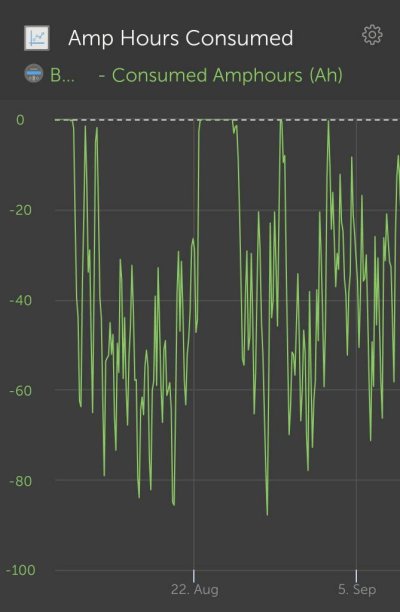jefndeb
Guru
Hello,
When we are at anchor, which is a bunch, we usually run the genset an hour or so in the morning too top up the house bank some and maybe use coffee maker, toaster etc. and again later in the early evening when making dinner and some hot water for showers.
When we hit the sack the battery SOC is usually around 93 to 96% and in the am its usually down to around 85 to 90% SOC.
(We have a single LG 375 watt PV panel that is enough, on a fairly sunny day, to actually provide around a 5 to 7 DC charging amps even while running basic daytime things to include the fridge/freezer.)
Just wondering if 80 to 85 amp hours consumed overnight would be considered similar to most cruisers based on a House bank 440ah AGM bank (2 8D) and your nighttime loads, and all those dang parasite mini loads.
It looks to me that when everything is shut down for the night the only load showing is about 5 or 6 amps which is the fridge running and maybe a DC fan and anchor light.
This screenshot is a 30 day graph showing the AH usage (there are 2 days in the middle where we were at a marina and plugged in and did not use any AH)
Thanks for your comments...
Jeff
When we are at anchor, which is a bunch, we usually run the genset an hour or so in the morning too top up the house bank some and maybe use coffee maker, toaster etc. and again later in the early evening when making dinner and some hot water for showers.
When we hit the sack the battery SOC is usually around 93 to 96% and in the am its usually down to around 85 to 90% SOC.
(We have a single LG 375 watt PV panel that is enough, on a fairly sunny day, to actually provide around a 5 to 7 DC charging amps even while running basic daytime things to include the fridge/freezer.)
Just wondering if 80 to 85 amp hours consumed overnight would be considered similar to most cruisers based on a House bank 440ah AGM bank (2 8D) and your nighttime loads, and all those dang parasite mini loads.
It looks to me that when everything is shut down for the night the only load showing is about 5 or 6 amps which is the fridge running and maybe a DC fan and anchor light.
This screenshot is a 30 day graph showing the AH usage (there are 2 days in the middle where we were at a marina and plugged in and did not use any AH)
Thanks for your comments...
Jeff





